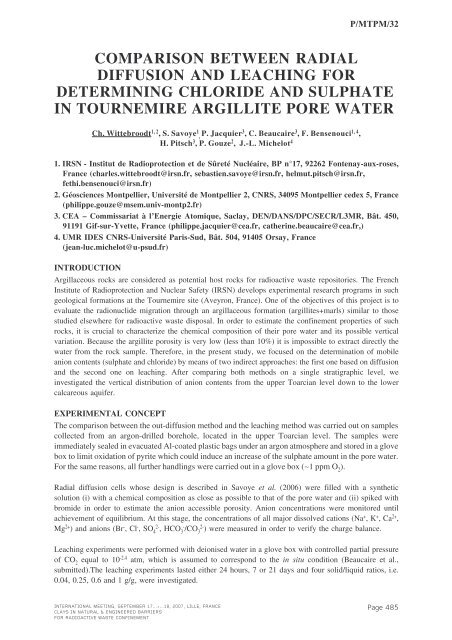Mass Transfer & Porous Media (MTPM) - Andra
Mass Transfer & Porous Media (MTPM) - Andra
Mass Transfer & Porous Media (MTPM) - Andra
Create successful ePaper yourself
Turn your PDF publications into a flip-book with our unique Google optimized e-Paper software.
P/<strong>MTPM</strong>/32COMPARISON BETWEEN RADIALDIFFUSION AND LEACHING FORDETERMINING CHLORIDE AND SULPHATEIN TOURNEMIRE ARGILLITE PORE WATERCh. Wittebroodt 1, 2 , S. Savoye 1 , P. Jacquier 3 , C. Beaucaire 3 , F. Bensenouci 1, 4 ,H. Pitsch 3 , P. Gouze 2 , J.-L. Michelot 41. IRSN - Institut de Radioprotection et de Sûreté Nucléaire, BP n°17, 92262 Fontenay-aux-roses,France (charles.wittebroodt@irsn.fr, sebastien.savoye@irsn.fr, helmut.pitsch@irsn.fr,fethi.bensenouci@irsn.fr)2. Géosciences Montpellier, Université de Montpellier 2, CNRS, 34095 Montpellier cedex 5, France(philippe.gouze@msem.univ-montp2.fr)3. CEA – Commissariat à l’Energie Atomique, Saclay, DEN/DANS/DPC/SECR/L3MR, Bât. 450,91191 Gif-sur-Yvette, France (philippe.jacquier@cea.fr, catherine.beaucaire@cea.fr,)4. UMR IDES CNRS-Université Paris-Sud, Bât. 504, 91405 Orsay, France(jean-luc.michelot@u-psud.fr)INTRODUCTIONArgillaceous rocks are considered as potential host rocks for radioactive waste repositories. The FrenchInstitute of Radioprotection and Nuclear Safety (IRSN) develops experimental research programs in suchgeological formations at the Tournemire site (Aveyron, France). One of the objectives of this project is toevaluate the radionuclide migration through an argillaceous formation (argillites+marls) similar to thosestudied elsewhere for radioactive waste disposal. In order to estimate the confinement properties of suchrocks, it is crucial to characterize the chemical composition of their pore water and its possible verticalvariation. Because the argillite porosity is very low (less than 10%) it is impossible to extract directly thewater from the rock sample. Therefore, in the present study, we focused on the determination of mobileanion contents (sulphate and chloride) by means of two indirect approaches: the first one based on diffusionand the second one on leaching. After comparing both methods on a single stratigraphic level, weinvestigated the vertical distribution of anion contents from the upper Toarcian level down to the lowercalcareous aquifer.EXPERIMENTAL CONCEPTThe comparison between the out-diffusion method and the leaching method was carried out on samplescollected from an argon-drilled borehole, located in the upper Toarcian level. The samples wereimmediately sealed in evacuated Al-coated plastic bags under an argon atmosphere and stored in a glovebox to limit oxidation of pyrite which could induce an increase of the sulphate amount in the pore water.For the same reasons, all further handlings were carried out in a glovebox( ∼ 1 ppm O 2 ).Radial diffusion cells whose design is described in Savoye et al. (2006) were filled with a syntheticsolution (i) with a chemical composition as close as possible to that of the pore water and (ii) spiked withbromide in order to estimate the anion accessible porosity. Anion concentrations were monitored untilachievement of equilibrium. At this stage, the concentrations of all major dissolved cations (Na + , K + , Ca 2+ ,Mg 2+ ) and anions (Br - , Cl - , SO 4 2- , HCO 3 - /CO 3 2- ) were measured in order to verify the charge balance.Leaching experiments were performed with deionised water in a glove box with controlled partial pressureof CO 2 equal to 10 -2.4 atm, which is assumed to correspond to the in situ condition (Beaucaire et al.,submitted).The leaching experiments lasted either 24 hours, 7 or 21 days and four solid/liquid ratios, i.e.0.04, 0.25, 0.6 and 1 g/g, were investigated.INTERNATIONAL MEETING, SEPTEMBER 17...>...18, 2007, LILLE, FRANCECLAYS IN NATURAL & ENGINEERED BARRIERSFOR RADIOACTIVE WASTE CONFINEMENTPage 485
















